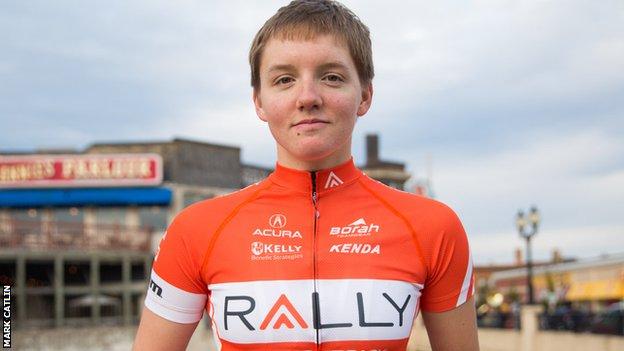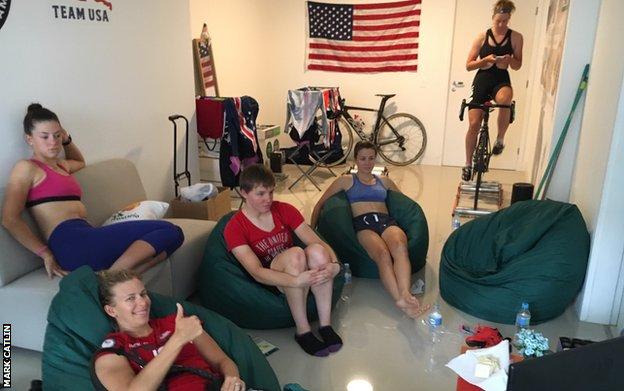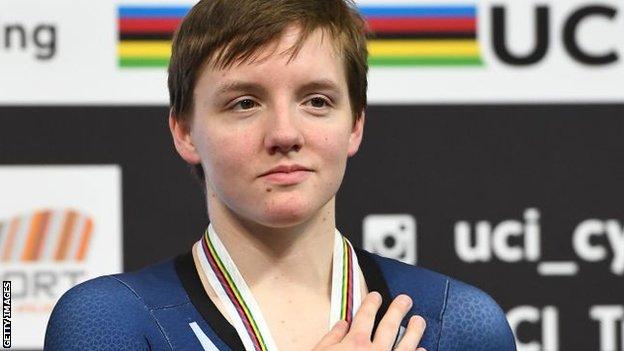Products You May Like


In January 2019, on a sunny day in the coastal mountains surrounding San Francisco, an Olympic medal-winning cyclist was racing down a twisting ribbon of tarmac, descending at the kind of blistering speed reserved for cars and motorbikes.
On a surface that had dried quickly after the first rainfall for weeks, Kelly Catlin suddenly lost control.
Her bike flew out from underneath her and tumbled down the hillside, coming to a stop in a cloud of dust. She was carried forward and skidded across the road, tumbling several times.
Catlin knew the drill of the hardened cyclist: jump up, survey the bike, examine the burning road rash and torn Lycra, get back up and finish the ride.
She seemed OK. She headed home. Later she spoke with her mum on the phone.
“She was telling me about it and kind of laughing,” Catlin’s mother Carolyn Emory told BBC World Service.
“I asked her: ‘Did you check your helmet?’ ‘No it’s fine,’ she said. But then she did check and it had dents on the front and back.”
Catlin didn’t realise at the time, but she had suffered a concussion. Soon after, she began to experience painful and confusing symptoms. Her mood and behaviour changed, she became anxious and depressed. Her family was worried – she no longer seemed herself.
Two months later, Catlin had taken her own life. She was 23.
Looking for answers has been a long, painful and complex journey for her family.
But they believe doing so will help raise awareness about an issue that sport – and especially cycling – has for too long ignored.

One of triplets, Catlin was a gifted athlete growing up. She seemed destined to achieve in almost any sport she liked. She was an especially talented football player, but when injuries saw her take up cycling as a way of keeping fit on the sidelines, there was no going back.
“It was like she was born with this drive or obsessiveness. Not to be an Olympic athlete necessarily, but to excel or to be good at something,” says her father Mark.
“Anything she focused on, she really focused. Art, Chinese… With school assignments she would do it and go beyond. Cycling was the thing it got channelled into.”
By the time of her crash, Catlin was a postgraduate computer science student at Stanford University in California, a three-time world track cycling champion in the team pursuit and an Olympics silver medallist with the United States.
She was out that day as part of her training with professional team Rally Cycling, one of America’s best. She had no idea how seriously her injuries would go on to affect her.
Weeks afterwards, she was still in constant pain and discomfort. Doctors’ diagnoses could not pinpoint exactly what was wrong.
“She went to Germany for a World Cup thing, but she couldn’t do it because she had severe headaches,” says Carolyn. “She stayed an extra week after the team left because she couldn’t cope with the airport lights and the noise.”
Mark adds: “She went to the Olympic Training Centre (OTC) and had a whole bunch of scans which didn’t show up an awful lot.
“Then things went downhill. They put her on some therapy for dizziness, light sensitivity and headaches. She had eye exercises. They trained her with all sorts of monitors and oxygen and blood pressure – all that stuff. Something was definitely wrong.”

Catlin attempted suicide at the end of January 2019, but did not succeed.
“Part of her brain knew it was too much after the first attempt,” says Carolyn. “She gave us her word she would not try again.
“But she talked to her sister on the phone a couple of days before she killed herself and said she was still thinking about it. She referred to: ‘If things don’t change in a month…’
“It was almost a goodbye.”
Mark adds: “She gave us her word, but in fact I think she just said that to get out of hospital. The staff realised it wasn’t the right thing to do to let her go, but she was going to get a lawyer – she was determined to get out.”
Soon after Catlin’s phone call with her sister, and following a campus wellness check initiated by Carolyn after a series of unanswered phone calls, Catlin was found dead in her apartment at Stanford in March 2019.
Her father Mark believes his daughter would still be alive had her symptoms, which included depression and anxiety, been recognised as evidence of post-concussion syndrome (PCS). Catlin had suffered several concussions – the crash was not her first – but the link was not made.
If it had been, Mark believes, Catlin would have followed guidance to take several weeks’ full rest, after which time, in many cases, PCS symptoms ease and patients recover. However, continuing to combine her cycling and studies, Catlin had been as busy as ever; determined to achieve, restless and intense in her pursuit of excellence, just like she always was.
Catlin’s family believe the symptoms she was experiencing, combined with this complex edge to her personality, proved too much for her; a woman whose drive for perfection was focused on fulfilling potential.
According to the Washington Post, her diaries later revealed she lived by a set of guidelines which included “I do not cry”.

We often see elite sport as the pinnacle of human performance. With it comes a perception that an athlete cannot be too dedicated in their pursuit of glory, that practice makes perfect. We think of their resilience or stoicism in the same way. A ‘we go again’ philosophy many champions possess.
Catlin referred to this herself in a blog post for the website VeloNews, published in late February 2019, shortly before her death.
She wrote: “As athletes, we are all socially programmed to be stoic with our pain, to bear our burdens and not complain, even when such stoicism reaches the point of stupidity and those burdens begin to damage us. These are hard habits to break.
“The truth is that most of the time, I don’t make everything work. It’s like juggling with knives, but I really am dropping a lot of them. It’s just that most of them hit the floor and not me.”
Brain injury remains poorly understood in the sporting world. Only in recent years has awareness begun to grow around the degenerative condition chronic traumatic encephalopathy (CTE) and its links with repeated blows to the head, and/or concussion.
The UK charity Headway has played a major role in developing interventions to mitigate against risks facing athletes, while also campaigning for wider understanding of post-concussion syndrome, too.
Because while CTE tends to develop later in life, with symptoms similar to Alzheimer’s disease and can currently only be fully diagnosed post-mortem, PCS is experienced in the immediate weeks or months after a concussion.
A key phrase from Headway’s campaign work is: ‘If in doubt, sit it out.’ The reality of the cycling world can often be found a long way from that message.
In road cycling, a rider must quickly get back on their bike following a crash to avoid they losing touch with the peloton and missing a time limit, causing elimination.
Last year’s men’s road cycling season saw some high-profile instances of concussion – one during each of the three Grand Tour races. The most concerning came at the 2020 Tour de France, in which Frenchman Romain Bardet crashed on stage 13.
He was contesting the lead of the race, but after crashing was clearly disorientated when he was lifted on to his feet, and his legs gave way and he collapsed. Within a minute he was back on his bike. He finished the 192km stage before it was revealed he not only had concussion, but had suffered a brain haemorrhage.
Several of Catlin’s USA Cycling counterparts have highlighted their concerns over concussions they suffered during their careers on the track, including 2020 world time trial champion Chloe Dygert and US time trial champion Carmen Small, who says her career was eventually ended by it.
“All athletes want to keep pushing when they should probably stop,” Small has said. “I still have headaches. I was never diagnosed, but I remember being out of it for four days in a dark room and having vertigo for six weeks.”
Since Catlin’s death, USA Cycling has launched a wellbeing programme and “multiple strategic initiatives aimed at changing the narrative around mental health”.

There are some other early signs of progress.
On Friday, the UK government published new plans to develop protocols around concussion in sport, following a July report from the Department for Culture, Media and Sport.
Cycling’s governing body the UCI has introduced new measures to better ensure the safety of athletes following head injuries. Team members will be trained to recognise the signs of concussion, record every incident centrally and follow a set time limit for recovery and returning to competition.
And during this year’s Paris-Nice, Britain’s 2020 Giro d’Italia champion Tao Geoghegan Hart was pulled out of the race after his team Ineos Grenadiers opted for caution – a move which was widely praised.

Following Catlin’s death, her parents donated her brain to the Concussion Legacy Foundation Brain Bank at Boston University to aid further research into the effects of concussion.
In a statement released at the same time, her father Mark identified four areas of possible cause: Personality, stress, overtraining and concussion.
Mark says: “Kelly was such a complex individual and very private – one who kept a lot of feelings inside and kept a veneer of: ‘I’m an iron woman.’
“She wouldn’t reveal her emotional or psychical situation, probably to anybody. She kept pushing herself when she shouldn’t have been. It all had a cumulative effect on her, a very strong woman brought down by that combination.
“It’s like part of us is torn out. I wake up every morning with a sense of disbelief she’s gone. Every night I wake up and play over and over in my head: ‘If only I’d done this…’
Carolyn adds: “We don’t want any other athletes to go through this. Short of getting Kelly back, we just want to get the right programme to help folk before it’s too late.
“I just wish she was still here.”
Mark Catlin and Carolyn Emory were interviewed for BBC World Service by Delyth Lloyd.
If you have been affected by the issues raised in this article, help and support is available via BBC Action Line.
